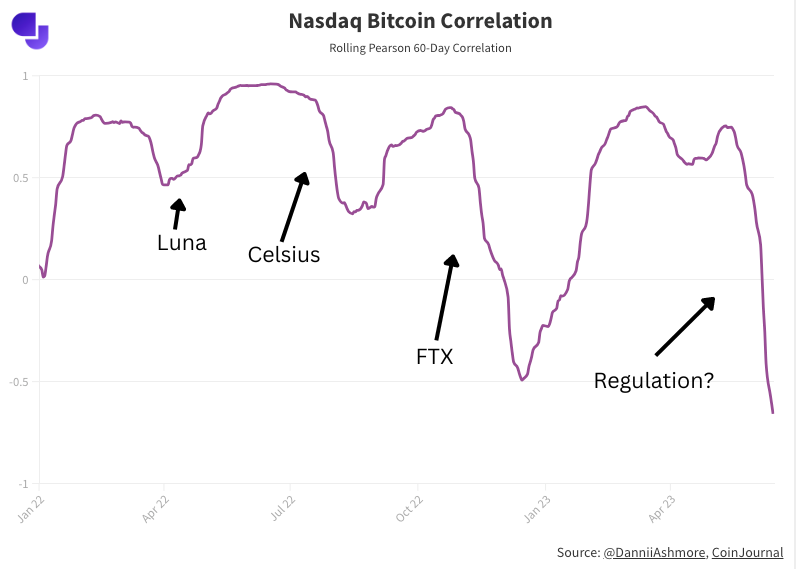[ad_1]

Key Takeaways
- Our Head of Research, Dan Ashmore, digs into Bitcoin’s relationship with stocks
- Correlation between Bitcoin and the Nasdaq is at its lowest level since 2018
- The Nasdaq is up 10% within the final month as stocks have surged off softer forecasts round rates of interest and the macro local weather
- Bitcoin is down 9% in the identical timeframe, the US regulatory crackdown spreading worry about crypto’s future within the nation
- Ashmore writes that the break in correlation surpasses what was seen in November 2022 amid the FTX collapse, when Bitcoin fell to $15,000 whereas stocks elevated off constructive inflation readings
After ten consecutive rate of interest hikes, the US Federal Reserve this week paused its charge mountain climbing coverage. The transfer was practically unanimously anticipated by the market and motion after the assembly was comparatively minimal.
However, over the previous month, markets have been flying. The S&P 500 is up 6% within the final 30 days, now solely 8.8% off an all-time excessive, regardless of being 27% beneath the mark in October. The Nasdaq is up 10% over the identical timeframe – that’s 15% beneath its all-time excessive from November 2021 however an incredible resurgence contemplating it shed a 3rd of its worth in 2022.
And but, one thing is being left behind: Bitcoin.
Bitcoin is now buying and selling beneath $25,000 for the primary time in three months. I put collectively a deep dive in March analysing the its underlying value motion to point out how tightly it trades with the inventory market. This was at a time when Bitcoin was rallying and banks have been wobbling amid the Silicon Valley Bank fiasco. Suddenly, it was modern to declare Bitcoin as decoupling from the inventory market. Ultimately, that wasn’t true. However, one thing very fascinating has occurred within the final month.
First, have a look at the trail of the Nasdaq and Bitcoin for the reason that begin of 2022, which roughly coincides with the beginning of the bear market:
Clearly, the 2 have moved in lockstep. But two episodes bounce out: the primary is November 2022, when Bitcoin fell and the Nasdaq surged. The second is that this previous month. We mentioned the ten% bounce within the Nasdaq over the past month. However, Bitcoin has fallen 9% in the identical timeframe. This marks a transparent departure from what we’d anticipate. Plotting the correlation (utilizing 60-Day Pearson) exhibits this extra instantly:
I touched on November 2022 above, and the swift fall in correlation will be seen on the chart. This was when FTX collapsed, sending the crypto market right into a tailspin. At the identical time, nonetheless, stocks raced upwards as softer inflation numbers have been met by decrease expectations across the future path of rates of interest.
There have been additionally much less dramatic (however equally non permanent) decouplings between Bitcoin and stocks in April/May 2022 and June/July 2022. On the chart beneath, I’ve pencilled in incidents which occurred throughout these durations:
 Indeed, what’s completely different about November (FTX) and as we speak is that we see a Bitcoin fall taking place at the identical time as a Nasdaq surge. While the Luna and Celsius incidents harm crypto immensely, they got here as stocks have been additionally struggling and so the impact will not be as dramatic when it comes to correlation breaks (though continues to be tangible on the chart).
Indeed, what’s completely different about November (FTX) and as we speak is that we see a Bitcoin fall taking place at the identical time as a Nasdaq surge. While the Luna and Celsius incidents harm crypto immensely, they got here as stocks have been additionally struggling and so the impact will not be as dramatic when it comes to correlation breaks (though continues to be tangible on the chart).
But as we speak, we’re seeing the largest break within the correlation development over the past couple of years – surpassing even FTX. The 60-Day Pearson at the moment sits at -0.66, whereas the bottom it hit through the FTX disaster was -0.49.
Regulatory crackdown is suppressing costs
The purpose is apparent. The nice regulatory crackdown within the US is freaking the market out, and for superb purpose. The two largest crypto firms on the planet, Binance and Coinbase, have been each sued final week.
Crypto.com has suspended its institutional trade, citing weak demand amid the regulatory woes. eToro and Robinhood pulled a bunch of tokens from their platforms following affirmation from the SEC that it seen them as securities. Liquidity is dropping like a stone.
I wrote in-depth concerning the concern following the announcement of the Coinbase lawsuit final week, so I gained’t rehash it right here (that evaluation is here). While I imagine Bitcoin ought to be capable of climate the storm long-term, the image seems far murkier for different cryptocurrencies.
Make no mistake about it, the crypto business faces a large downside as lengthy as lawmakers proceed to show the screw. The disaster very a lot feels existential for lots of the crypto market.
Regarding Bitcoin, fanatics dream of a day when it may possibly decouple and declare that title of uncorrelated hedge asset, or a store-of-value, akin to gold. I’ve performed a variety of work round what that hypothetical future may appear like, or what could lead on the market to that time. But for now this stays simply that: hypothetical. Because whereas the correlation is at its lowest level in 5 years, it isn’t being pushed by fundamentals and thus will inevitably spike again up. This is nothing greater than the market reacting to what’s a really bearish growth round regulation within the US.
It’s not how traders hoped a decoupling would come. But if anybody doubted the market’s worry over the regulatory woes, or questioned why Bitcoin had not fallen extra, wanting at the break in correlation paints a really clear image of how detrimental Gary Gensler’s video games have been to the cryptocurrency business.
In reality, it isn’t hyperbole to say that that is essentially the most out of whack Bitcoin’s correlation has ever been while buying and selling as a mainstream monetary asset. Because again when it final occurred in 2018, Bitcoin traded with such skinny liquidity that its value motion is essentially irrelevant to attract conclusions from going ahead.
[ad_2]
Source link



